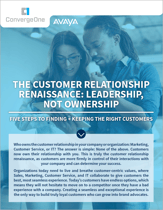The Customer Relationship Renaissance
Posted by C1 on Sep 10, 2019 10:00:00 AM
Who owns the customer relationship in your company or organization: Marketing, Customer Service, or IT? Fifteen years ago, the answer was clear: Customer Service, period. Over time, the answer has become murkier. Once customers began researching a product or service prior to purchase—a phenomenon Google coined the “Zero Moment of Truth”—a shift occurred. Marketing began to lay claim to the customer relationship. This was due, in large part, to the bevy of channels available to customers—such as browsers, apps, and social media—prior to communicating with a company. Fast forward to the present day and customers are empowered with even more resources to answer their own questions and conduct their own due diligence before contacting a company.
This is undoubtedly great news for customers, but it’s causing problems for companies that fail to keep pace with change. Many continue to treat their customers traditionally and approach customer service in a siloed manner. Companies that wish to provide a modern customer experience must figure out the answer to one important question: With the enormous amount of information unlocked by the Internet to inform and propel the customer decision-making process, who really owns the customer relationship?
The answer is simple: Customers now own their relationship with a company. They are more firmly in control of their interactions with a company, and if your company embraces this notion and leverages technology to provide world-class service, your customers will feel the improvement in their experience.
Customer Centricity is Paramount to Survival
In today’s technology-infused world, the idea of customer ownership has dramatically changed. An organization —including all of its employees, departments, and authorized representatives—only has access to the information customers choose to share during their decision-making journey and the following support cycles. Because customers are conducting so much outside research, there are significant gaps in an organization’s understanding of how and what customers are learning about the company and its products.
Marketing researches and crafts effective customer communications based on empirical data about how customers interact with the company or competition via channels like the Internet, mobile devices and apps, automated systems, self-service portals, voice, email, chat and SMS, and customer/patient portals. At the same time, customers are learning about the company in a number of other ways, including virtual assistants (also known as BOTs or automated assistants), pop-up suggestions and product guides, friends, groups and forums, knowledge workers, and agents.
An organization’s public relations efforts and social media presence also factor greatly into a customer’s decision-making process. Social media has emerged as a key change agent in the debate over customer ownership, as it has effectively blurred the lines between functions that traditionally operated as silos. Previously, departments would establish lines of communication with a customer depending on the stage of his or her decision journey. Following social media’s rise in prominence, today’s digital customers can now determine how they want to communicate with a company, all in a very public forum. They will often share their experiences—good and bad—about a product or service online.
For this reason, a fluid dialogue among all departments—rather than the siloed approach of years past—is needed in order to find and keep loyal customers. Instead of protecting their proverbial turf, Sales, Marketing, Customer Service, and IT functions must work together to create value and project a unified voice to customers. This shift can be challenging; in most organizations, these functions operate under different reporting structures, goals, and success metrics. However, one quality that they all share in common is that they work on behalf of the customer, whether they realize it or not. That common bond must drive them to come together to deliver the modern experience that customers demand.
Are you growing your customers into brand advocates?

Creating a seamless and exceptional experience is the only way to build truly loyal customers who can grow into brand advocates—so how can you do it? In this ConvergeOne + Avaya white paper, we share five steps to finding and keeping the right customers. Download our white paper today to ensure you're fully prepared for the customer relationship renaissance.
Topics: Customer Experience



